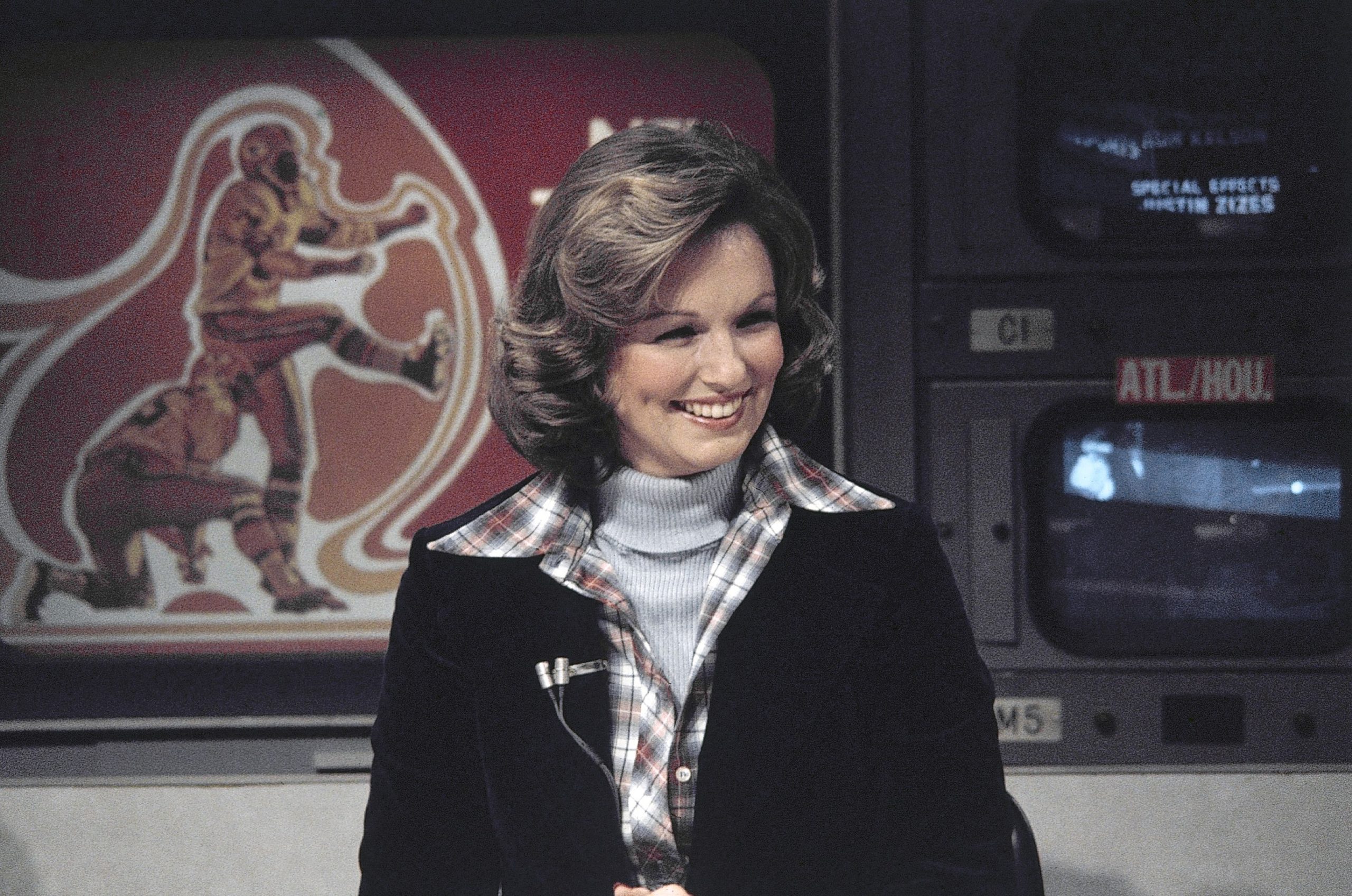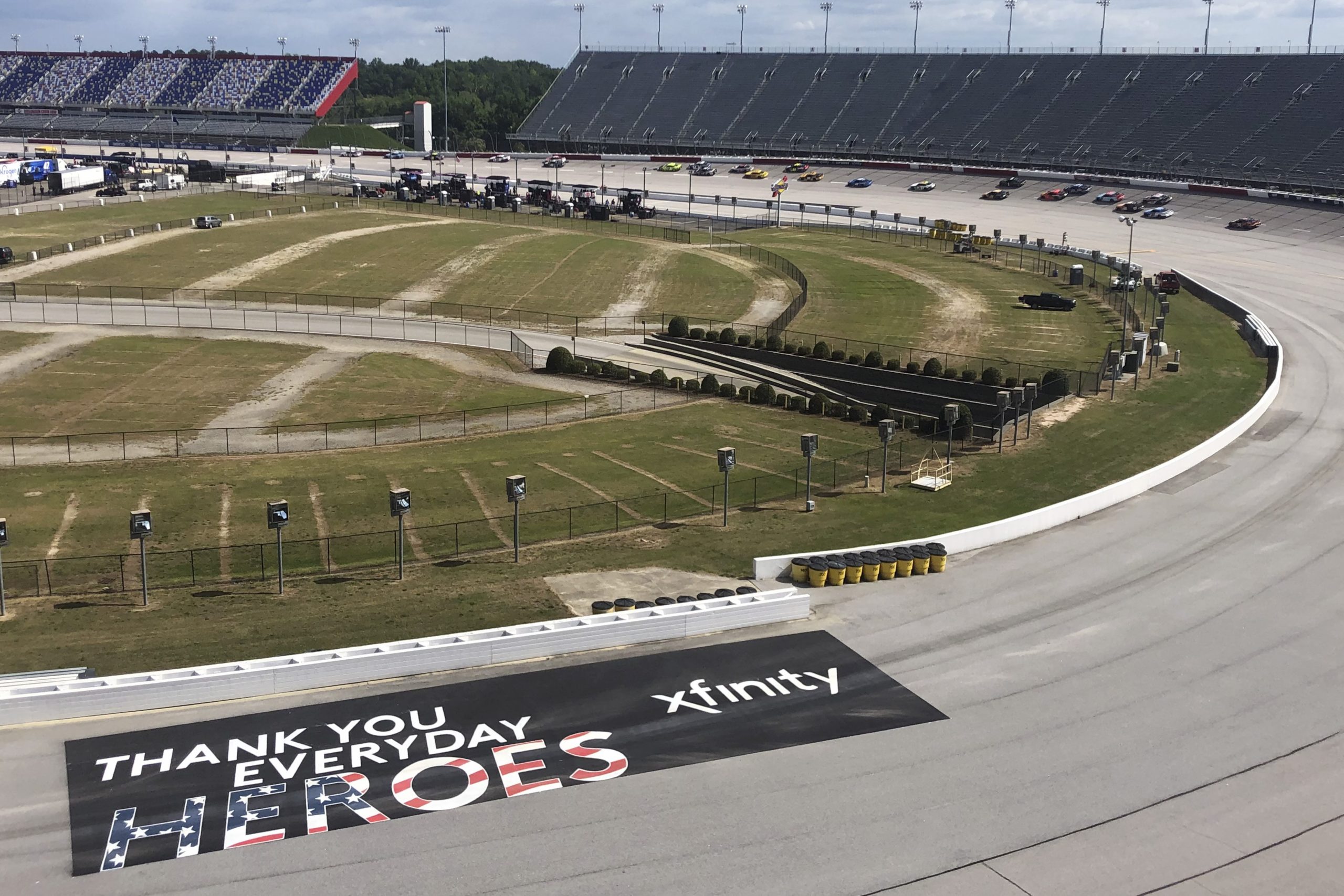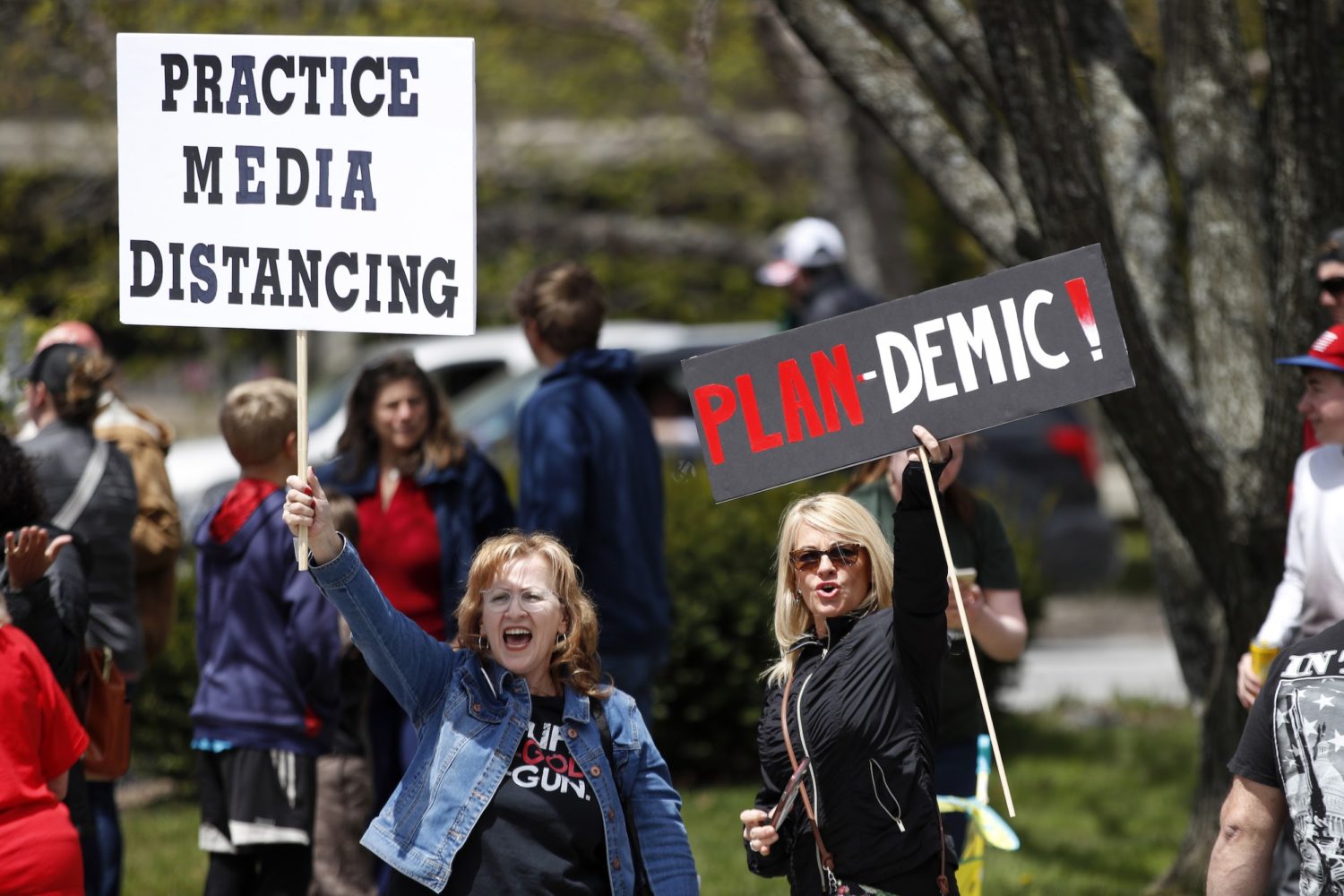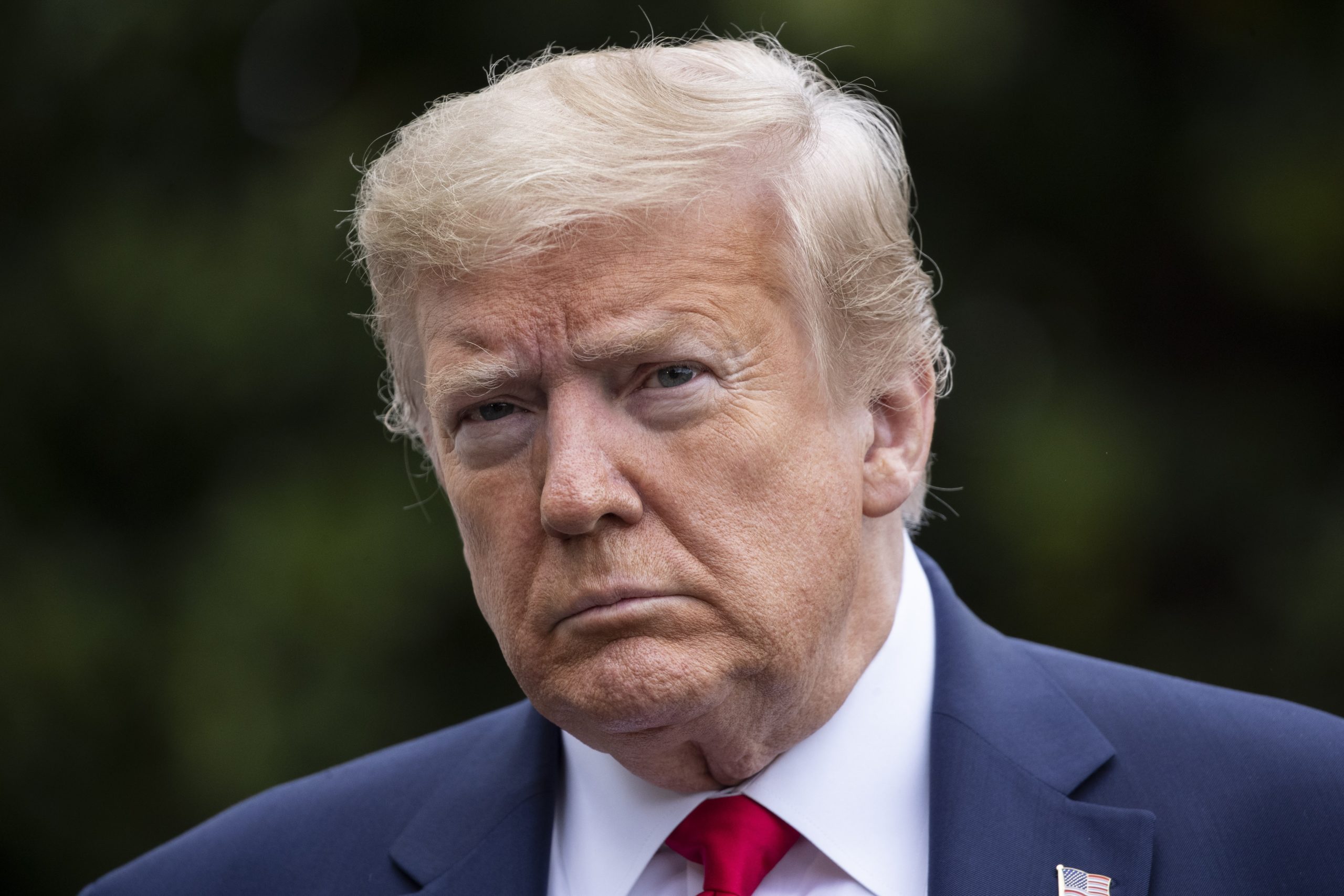The Poynter Report is our daily media newsletter. To have it delivered to your inbox Monday-Friday, click here.
Kevin Vesey is a reporter for News 12, a streaming news outlet on Long Island. Over the weekend, he was covering a protest from those who want the country to be reopened. As he filmed the protesters, Vesey was verbally harassed with comments of “fake news” and “enemy of the people” and chants of “fake news is not essential.”
Another protester wearing a Trump shirt repeatedly stepped toward Vesey even after Vesey asked him to back away. The protester said, “No, I got hydroxychloroquine, I’m fine” and then gave the camera a middle finger.
I recently wrote how protesters in Phoenix mocked reporters for wearing masks, saying things like “you’re on the wrong side of patriotism” and calling the reporters “communists.” The New York Times’ Marc Tracy has also written about reporters being confronted by protesters in Ohio, Michigan and California, where a man pulled a knife on a reporter.
Here’s the part I don’t get. Isn’t a big part of protesting to draw attention to your cause? Wouldn’t you want the media to be there?
So why would you threaten the reporters who are there to broadcast what you are saying? Few things put a damper on a protest like a lack of attention. A good way to make sure nobody knows about your protest is to menace the reporters there to cover you.
The sad part for the protesters is instead of discussing the merits and arguments for reopening the country, the only discussion coming out of those protests is how they treated the media. That’s the protesters’ fault.
Instead of giving thoughtful quotes about their personal experiences and why it’s important for the economy to get back on track, these protesters chose to use valuable airtime to accost the media and make sarcastic remarks about hydroxychloroquine. It’s a baffling choice that is short-sighted and pointless to their cause.
You might argue, “What’s the big deal?” These protests, in the grand scheme of things, don’t involve that many people. But here’s what makes it a big deal: The president of the United States is supporting these kinds of attacks on the media.
President Donald Trump retweeted the video of the Long Island protesters to his nearly 80 million Twitter followers and said, “People can’t get enough of this. Great people!”
With Trump condoning such behavior, it seems as if it’s only a matter of time before the verbal attacks become physical.
Sadly, I predict something tragic is going to happen as the protesters become bolder and bolder and their contempt for the media grows — a contempt fueled by the president.
That’s a lot of tweets
Speaking of Trump and tweeting, The Washington Post’s Philip Bump delved into just how much time Trump uses to tweet. Bump admits there is no way to know for sure how long it takes Trump to write and send a tweet or to read and then retweet another’s tweet. But Bump uses math that seems fair.
Assume that it takes Trump one minute to write and send his own original tweet or to retweet with a comment. And let’s also say it takes just one second to simply retweet someone else.
If you add it all up, here’s what you get: Trump has spent 9 days, 17 hours and 36 minutes tweeting since taking office.
Don’t agree that it takes that long for Trump to tweet? Or maybe you think it takes longer than that to tweet? Fine, the Post has done something cool. Bump’s story is interactive. You can guess how long it takes for Trump to tweet. Fill in the number yourself and then see how much time he has spent tweeting.
One more item about Trump’s tweets
On Sunday, Trump’s pinned tweet was simply one word: “Obamagate.” What is it? Even Trump, when asked by a reporter, really hasn’t explained. But expect to see more and more of that word coming out Trump’s Twitter feed and mouth in the coming days, weeks and months.
But Vox’s Sean Illing warns the media needs to be careful with this word and this story. Illing notes that it doesn’t matter if the story, whatever it is, is false — what matters is how much the media pays attention to it.
“The important thing is that we’re talking about it at all,” Illing writes, “and we’re only talking about it because the president wants us to talk about it.”
Illing notes that if we’re talking about “Obamagate” then we’re not talking about things such as coronavirus deaths and unemployment and the economy and other topics Trump would rather us avoid at the moment. The problem that Illing mentions — and he’s right — is that Trump tweets it, his supporters among the right-wing media amplify it and then the rest of the media chases it.
In other words, the media might chase a non-story while ignoring important ones. Or, ask this: is “Obamagate” just another word for “Hillary’s emails?”
Illing writes, “Obamagate is another example of this systemic failure. Here we have — and I can’t say this enough — a complete non-scandal. There’s no ‘there’ there. It’s pure misinformation. But we’re still talking about it.”
And Illing is writing about it. And I’m writing about it. It’s an endless cycle, and the reason why you will see Trump tweet it and watch Fox News discuss it and hear Rush Limbaugh talking about it. And then everyone else chases it.
More conspiracy theories
Obamagate is hardly the only conspiracy theory floating around out there. More prominent are the various COVID-19 conspiracies, something that NBC national security analyst Clint Watts calls a “disinformation bonfire.” Watts said these conspiracies are well planned and well organized and that a concerted effort is being made to spread them. It’s not simply that theories that someone throws out there go viral on their own, although social media does help spread them.
What’s the media’s role? Does bringing up conspiracies in order to discredit them in a way, actually, amplify them and give them more credence?
Watts told “Meet the Press” moderator Chuck Todd, “If you don’t address the conspiracy and it continues — if there is no rebuttal, people tend to believe things if you have no rebuttal. If you don’t rebut it then that conspiracy continues to spread. But at the same point, if you actually go and challenge that conspiracy, sometimes it can call more attention to it, it can draw more evaluation. It’s a delicate balance in the media and the social media companies with about to police this sort of information.
Watts recommends looking at the outlets who are producing the information and then asking: How are they making their money? Or is it for an ideological cause? And then trust the experts after identifying that they are, indeed, experts.
Speaking of conspiracy theories, The Atlantic has an exceptional new project on conspiracies called Shadowland. Check it out. It’s well worth your time.
Remembering a legend

In this Nov. 28, 1976 file photo, CBS sportscaster Phyllis George is seen in New York on the set of CBS’s “The NFL Today.” (AP Photo/Suzanne Vlamis, File)
CBS’s “The NFL Today” was one of the most groundbreaking shows in the history of television back in the 1970s.
Aside from host Brent Musburger, it had Irv Cross, who is believed to be the first African American to work full time as a sports analyst on a nationally televised show. The show also did something rare by fully embracing the gambling aspect of the sport by hiring Jimmy “The Greek” Snyder, a Las Vegas bookmaker.
And the show hired Phyllis George, who died over the weekend from complications of a blood disorder. She was 70. The 1971 Miss America joined the show in 1975, becoming the first female co-anchor of an NFL pregame show. George was on “The NFL Today” from 1975 to 1977 and then from 1980 to 1983.
ESPN’s Hannah Storm called George “the ultimate trailblazer.”
George faced the same baseless criticism that many female sports journalists face today: that she didn’t know the game. George reportedly kept a box of hate mail from those who criticized her.
She once told USA Today, “When you’re the first, you’re a pioneer. I felt they didn’t know who Phyllis George was. They played me up as a former Miss America, a sex symbol. I can’t help how I look, but below the surface, I was a hard-working woman. If I hadn’t made that work, women eventually would have come into sportscasting, but it would have taken them longer.”
Start your engines

Cars go through a turn past a sign thanking people working during the coronavirus pandemic at Darlington Raceway Sunday. (AP Photo/Jenna Fryer)
There were sports on TV Sunday. Real, live, actual sports. NASCAR returned with a race at Darlington Raceway in South Carolina and four of the top golf pros played a charity match in Florida.
First, NASCAR. There were no fans in the stands, and the crew wore masks, but it was a live sporting event. Fox was there to cover it and, if you’re not familiar, Fox Sports’ production of NASCAR is excellent — with the one exception that the broadcasters tend to be pro-NASCAR a little too often. But, all in all, it’s really good sports television.
As far as Sunday, here was the big question: What was it like for viewers to watch a sporting event without fans?
It took only a few moments to visually adjust but the thing that Fox and NASCAR had going for it was that the sound of auto races typically drowns out the crowd noise anyway. And I’ve felt that the lack of crowd noise will be the oddest part about having no fans at televised sporting events.
NASCAR is probably best equipped to have as close-as-normal TV viewing without fans. Their absence will be much more noticeable in sports such as football, baseball, basketball and hockey.
The golf match, aired by NBC, was better than watching an old tournament, but it was definitely weird without fans.
A surprise guest
NBC’s coverage of Sunday’s golf — officially called TaylorMade Driving Relief — featured a call-in guest: President Trump. The event — with golfers Rory McIlroy, Dustin Johnson, Rickie Fowler and Matthew Wolff — was to raise money and awareness for the American Nurses Foundation and CDC Foundation.
At such a polarizing time, it did seem like a controversial decision by NBC to have Trump on, and social media reacted with many people saying they turned away because of it. Then again, if I ran a network, and the president called into a broadcast, I would have him on.
What’s interesting is McIlroy has been critical of Trump, particularly his coronavirus response. On a recent McKellar Golf podcast, McIlroy said, “We’re in the midst of something that’s pretty serious right now. The fact that he’s trying to politicize it and make it a campaign rally and say we administer the most tests in the world like it is a contest, there’s some stuff that just is terrible. It’s not the way a leader should act. There is a bit of, sort of, diplomacy that you need to show, and I just don’t think he’s shown that, especially in these times.”
Another interesting moment came when Trump told NBC golf announcer Mike Tirico that he enjoyed playing golf with Tirico in the past. Tirico told Trump, “We got to see firsthand what a good putter you are. You knock it to kick in distance very often.”
But one couldn’t help but remember a story from sportswriter Rick Reilly’s book about Trump and golf. In the book, Reilly talked about Trump’s cheating while playing. One story was about when Tirico hit a great shot on a par 5, only to find it in the sand trap with no idea how it got there. In the book, Tirico said, “Trump’s caddy came up to me and said, ‘You know that shot you hit on the par 5? It was about 10 feet from the hole. Trump threw it in the bunker. I watched him do it.’”
That story did not come up during Tirico’s on-air chat with the president.
Hot type
- A heartwarming and interesting “CBS Sunday Morning” piece about “CBS This Morning’s” Tony Dokoupil and MSNBC’s Katy Tur, a married couple both doing their TV shows from their home basement makeshift studio while taking care of their 1-year-old.’
- The Washington Post’s Ariana Eunjung Cha and Chelsea Janes with “The Girl Who Died Twice” — the story of a 12-year-old who survived two heart attacks that might have been caused by the coronavirus.
- With somber photos from Philip Montgomery and text by Maggie Jones, The New York Times Magazine asks, “How Do You Maintain Dignity for the Dead in a Pandemic?”
- Are coronavirus deaths in the U.S. undercounted or overcounted? Appearing on ABC’s “This Week,” FiveThirtyEight founder Nate Silver gives his thoughts.
Have feedback or a tip? Email Poynter senior media writer Tom Jones at tjones@poynter.org.
More resources for journalists
- Covering COVID-19 with Al Tompkins (daily briefing). — Poynter
- On Poynt Live training: May 21 at 2 p.m. Eastern — Niche newsletters: Bouncing Back From the COVID-19 Engagement Slump — Poynter
- Writing Through: The Power of Details In a Pandemic — May 19 at 11:30 a.m. Eastern — Journalism Institute, National Press Club
- Guide to Surviving a Layoff — May 20 at 7 p.m. Eastern — NAHJ (National Association of Hispanic Journalists)
Want to get this briefing in your inbox? Sign up here.








